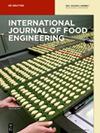Effect of ultrasound-ethanol immersion, microwave and starch-blanching pretreatments on drying kinetics, rehydration, and quality properties of beetroot chips
IF 1.4
4区 农林科学
Q3 FOOD SCIENCE & TECHNOLOGY
引用次数: 0
Abstract
Abstract For the first time, the impact of ultrasound-ethanol immersion as a non-thermal pretreatment (NTPT) and coating-blanching in starch solutions as a thermal pretreatment (TP) on the convective drying of beetroot was evaluated. The beetroot was exposed to ethanol immersion (E), ultrasound (U), and ultrasound-ethanol immersion (UE). Besides, TP pretreatment was performed by blanching the beetroot at steam (SB), water (WB), starch-coating solutions, and microwave (M). The hot air drying was conducted at 90 °C and air velocity of 1.2 m/s. The maximum decreases in the drying time were observed at UE30 (64.29 %) and the sample blanched at native corn starch solution (60.17 %). Moisture diffusion coefficients ranged from 0.851 to 2.312 × 10−9 m2/s. The friction drag force, convective heat, and mass transfer coefficients were 2.840 × 10−6 N, 59.368 W/m2 K, and 0.0492 m/s, respectively. The thermal conductivity, specific heat, and density ranged from 0.464 to 0.615 W/m. K, 3164–4071 J/kg. K, and 798.9 to 1055.9 kg/m3, respectively. The maximum values of rehydration ratio at non-thermal (NTPT) and thermal pretreatments (TP) were observed at U30 and the sample blanched at the modified starch solution (MCS), respectively. The total phenolic contents of the NTP sample decreased while those for the TP samples increased due to boosted polyphenol synthesis at high temperatures. Both U and E samples caused a decrease in the total antioxidant activity, while they increased the anthocyanin content of beetroot samples. Pretreatments reduced the hardness owing to changes in the microstructure of the sample. U, E, and M pretreatments increased the brightness of samples, and the minimum color change compared with control samples was observed by UE30 pretreatment. The UE and blanching at a starch solution could be selected for improving the drying characteristics of beetroots at an industrial scale.超声波-乙醇浸泡、微波和淀粉氽烫预处理对甜菜根片干燥动力学、再水化和质量特性的影响
摘要 首次评估了作为非热预处理(NTPT)的超声波-乙醇浸泡和作为热预处理(TP)的淀粉溶液涂布-漂白对甜菜根对流干燥的影响。甜菜根暴露于乙醇浸泡(E)、超声波(U)和超声波-乙醇浸泡(UE)。此外,还通过蒸汽(SB)、水(WB)、淀粉涂层溶液和微波(M)对甜菜根进行了焯水预处理。热空气干燥的温度为 90 °C,风速为 1.2 m/s。在 UE30(64.29%)和原生玉米淀粉溶液(60.17%)下焯过的样品的干燥时间缩短幅度最大。水分扩散系数在 0.851 到 2.312 × 10-9 m2/s 之间。摩擦阻力、对流热和传质系数分别为 2.840 × 10-6 N、59.368 W/m2 K 和 0.0492 m/s。导热系数、比热和密度分别为 0.464 至 0.615 W/m.K、3164-4071 J/kg.K 和 798.9 至 1055.9 kg/m3 之间。非热预处理(NTPT)和热预处理(TP)的复水率最大值分别出现在 U30 和改性淀粉溶液(MCS)焯过的样品上。由于高温促进了多酚的合成,NTP 样品的总酚含量下降,而 TP 样品的总酚含量上升。U 样品和 E 样品都导致总抗氧化活性下降,而甜菜根样品的花青素含量却增加了。由于样品的微观结构发生了变化,预处理降低了硬度。U、E 和 M 预处理增加了样品的亮度,与对照样品相比,UE30 预处理的颜色变化最小。可以选择 UE 和淀粉溶液焯烫来改善工业规模甜菜的干燥特性。
本文章由计算机程序翻译,如有差异,请以英文原文为准。
求助全文
约1分钟内获得全文
求助全文
来源期刊

International Journal of Food Engineering
FOOD SCIENCE & TECHNOLOGY-
CiteScore
2.50
自引率
0.00%
发文量
52
审稿时长
3.5 months
期刊介绍:
International Journal of Food Engineering is devoted to engineering disciplines related to processing foods. The areas of interest include heat, mass transfer and fluid flow in food processing; food microstructure development and characterization; application of artificial intelligence in food engineering research and in industry; food biotechnology; and mathematical modeling and software development for food processing purposes. Authors and editors come from top engineering programs around the world: the U.S., Canada, the U.K., and Western Europe, but also South America, Asia, Africa, and the Middle East.
 求助内容:
求助内容: 应助结果提醒方式:
应助结果提醒方式:


